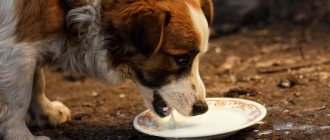Dogs love fruits, and owners willingly treat them to these products. But few people wonder whether dogs can have bananas. Like any product, fruit can be beneficial and harmful when fed to pets.
Considering the origins of our pets, banana is not a completely natural food for dogs.
However, through the process of domestication and long years of living with humans, the canines' digestive system has adapted to many new ingredients, including exotic treats. Important! But they need to be fed to pets with caution.
Useful microelements in bananas
This is one of the most common fruits; it can be found on sale everywhere. It is considered the oldest product of Southeast Asia.
Main beneficial properties:
- This is a high-calorie fruit (about 100 kcal is contained in 100 g).
- Although it is sweet, it has a low glycemic index (about 18 units).
- Contains non-digestible fiber, which gives the animal a feeling of fullness and promotes the formation of feces.
- The fruits contain a large amount of potassium. This microelement is important in the body (when consumed, blood pressure decreases, the likelihood of edema decreases, and the functioning of the cardiovascular system improves).
- The composition contains an enzyme that has a beneficial effect on the mucous membrane of the digestive tract, which is especially useful for peptic ulcers.
- Polysaccharides promote the growth of intestinal microflora.
Is it possible to give dogs bananas?
Most dogs readily eat bananas as they love the sweet taste. However, for an animal, fruit can bring both benefit and harm.
Benefit
Among the useful qualities are:
- Consumption of fruits improves the digestion process (stimulates intestinal motility, promotes the development of bacterial microflora).
- The vitamins in the fruit strengthen the immune system.
- Microelements make up for the deficiency during natural feeding.
- Potassium helps normalize water-salt balance.
Harm
Possible negative consequences:
- May cause an allergic reaction in the animal.
- The product is given to animals with diabetes mellitus with caution and in consultation with a doctor.
- Overripe fruit can cause fermentation in the stomach, causing bloating and soreness.
At what age can fruit be given?
Expert opinion
Kuzmenko Olga Olegovna
Information about the expert
Ask a Question
Dogs can start offering bananas at 2-3 months of age. “
No matter what age the pet is offered the product, this must be done while adhering to certain nuances:
- For the first 3-5 days, the pet is given a small piece of fruit (depending on the size of the animal, a little more can be used for larger ones) no more than once every 2-3 days.
- During this time, the general condition of the dog is monitored.
- If signs of an allergy or inability to digest the product appear, it is excluded for the next 6-12 months (in some cases for life).
- If no adverse reaction is noted, the portion can be slightly increased by chopping the fruit before feeding.
Can I feed dogs banana peels?
If you treat your pet to bananas, make sure to peel them. The peel is very difficult to chew (especially for small dogs) - your four-legged friends may simply choke on it.
Banana peels are also very difficult to digest. Plus, these fruits are often treated with various chemicals that accumulate in the peel.
How to properly feed your dog bananas?
Key points to consider:
- When choosing fruits, preference is given to yellow, ripe bananas.
- It is not recommended to store fruit in the refrigerator.
- An unripe product can be placed in a paper bag at room temperature, and within a few days it will be ready for feeding.
How to give to your pet:
- Before feeding the dog, wash the fruit and remove the banana peel;
- the product is offered to the pet fresh, crushed;
- It is better to give in the form of a treat, separately from the main meal;
- mixing with the main diet is acceptable, but with caution.
How often and how much can you feed your dog bananas:
- Representatives of small breeds are given treats 2-3 times a week. A single serving should be approximately 1/3 of a regular-sized fruit.
- Medium and large animals are given 1/2 or a whole banana 2-3 times a week.
It is not recommended to give to animals:
- Fried product.
- Dried bananas as they contain more calories and carbohydrates.
- Green or overripe fruits.
- If your pet eats commercial food, you should not give additional food. This can cause problems in the gastrointestinal tract.
Is it possible to give bananas to puppies?
It is useful for pregnant females to give the product in the usual dosage, according to the weight of the dog. There are no restrictions, other than individual allergies, for feeding banana to a lactating bitch. Puppies begin to be given banana complementary foods no earlier than 2 months. The first portion is 20–30% of the normal feed volume.
Some dogs are not able to digest fruit without consequences for their body. They experience lethargy, constipation or diarrhea, watery eyes, and a noticeable rash on the skin. If these signs are detected, stop feeding the banana and show the pet to a doctor.
Bananas can only be given in small doses to the following dogs:
- prone to obesity;
- the elderly and those leading a sedentary lifestyle;
- for allergy sufferers.
If your pet doesn’t like bananas, you can replace them in the diet with fresh apples, pears, melons, and plums (without seeds). Recommendations for feeding these products are the same as for giving bananas.
Signs that the fruit is not suitable for your dog
Signs that the product is not suitable for your pet may not appear immediately. In some cases, the reaction is detected even after several months or even years. Symptoms may include:
- Digestive disorder: constipation or diarrhea.
- Vomit.
- Redness on the skin in the groin area, axillary folds, and the inside of the ear.
- Itching.
- Peeling, dandruff appears on the fur.
- Swelling of the mucous membranes, conjunctiva.
- Discharge from the eyes.
Reference! To understand that the reaction occurred specifically to a banana, it is completely excluded from the diet. When improvements occur, a “provocation” is carried out - the fruit is given to the pet again. If symptoms reappear, we can conclude that treats should not be given to the pet.
Dogs love fruits and berries. These healthy products can and should be used as part of the diet when feeding a dog naturally. You just need to clarify which fruits a pug can eat. Plus, these products make great snack treats. Berries and fruits will perfectly cheer up your dog and enrich the body with vitamins. However, not all types of fruit and berry products are allowed for pugs.
Bananas for Pugs
Bananas contain protein, dietary fiber, vitamin B6, potassium, plant fiber, ascorbic acid, iron, magnesium, folic acid and other beneficial substances. In addition, bananas are very tasty and all dogs like them.
blueberries
These berries have many antioxidants, and they also contain useful and rare vitamin K, ascorbic acid, manganese, vitamin A, fiber, phosphorus, calcium, potassium, and folic acid. Blueberries can be eaten for brain health, strengthening the immune system, and preventing various dangerous diseases. Let's figure out what types of fruits you can still give your pug.
Strawberries for a pug
This magnificent berry is a rich source of vitamin C, as well as vitamin K, A, calcium minerals, folic acid, magnesium, phosphorus, and potassium. And strawberries for dogs can be a tasty and healthy treat with low calorie content and great benefits. In addition, strawberries can be frozen in the summer and given to dogs in the winter.
Apples for Pugs
When treating dogs with apples, you must make sure that the dog does not eat the seeds. After all, apple seeds contain poison. The pulp of this fruit has a lot of useful and valuable substances, namely vitamins C, A, K, phosphorus, magnesium, calcium and potassium. Just a few pieces of apples a day will help your pug avoid many canine diseases.
Pears
Pears contain ascorbic acid, vitamin K, folic acid, magnesium, calcium, potassium and phosphorus. A pear cut into pieces will be a wonderful treat for a pug.
cranberries
This wonderful berry maintains a healthy urinary system; cranberries perfectly help flush the kidneys and prevent urinary tract infections. Cranberries contain useful antioxidants, carotene, B vitamins, high concentrations of ascorbic acid, calcium, potassium and phosphorus.
Can pugs have watermelon?
Full of water and vitamins with a refreshing taste, watermelon is great for quenching dogs' thirst in hot, sultry weather. Watermelon has a large number of vitamins and microelements: vitamin K, A, magnesium, calcium, potassium, phosphorus and selenium.
Melon in a dog's diet
For a pug, melon is a valuable source of ascorbic acid, vitamin A, folic acid, vitamin K, Omega fatty acids, selenium, phosphorus, potassium and other beneficial substances. Melon can be a great dog snack option that will bring great pleasure and great benefits to your pug.
So you can safely give your pets healthy fresh fruits.
How to help if your pet becomes ill?
If the animal shows the first signs that the product has caused individual hypersensitivity, the following measures must be taken:
- Bananas and banana-containing products should be completely excluded from the pet’s diet for a long period of time.
- In case of indigestion (diarrhea, vomiting), the animal is placed on a 24-hour fasting diet, without limiting fluids.
- For 2-3 days, the dog is given enterosorbent (Enterosgel, Polysorb) diluted with water 2 times a day.
- In case of visible allergic manifestations (itching, rashes, redness, peeling), the animal is given antihistamines (Suprastin, Tavegil, Cetirizine).
- During the recovery period, easily digestible foods are left in the pet’s diet.
Expert opinion
Kuzmenko Olga Olegovna
Information about the expert
Ask a Question
If the animal experiences an acute reaction (swelling of the mucous membranes, difficulty breathing, apathetic state) or these measures do not have any positive effect, the dog must be shown to a veterinarian so that the process does not worsen.”
Whether dogs can eat bananas is a largely individual question. If the animal has no adverse reactions, then the fruit is given to the pet 2-3 times a week. It contains many useful substances that have a beneficial effect on the digestive process and are necessary for the body with a natural type of feeding.
Compound
Bananas actually contain many useful substances, the main ones being: vitamins B and C, potassium, magnesium and phosphorus, and it also contains inulin. Inulin is a natural polysaccharide that acts as a prebiotic in the intestines, positively affecting metabolism and the growth of beneficial microflora. Potassium stabilizes water balance and heart rhythm. Vitamin C strengthens the immune system, and B vitamins are involved in a large number of metabolic processes in the animal’s body.











